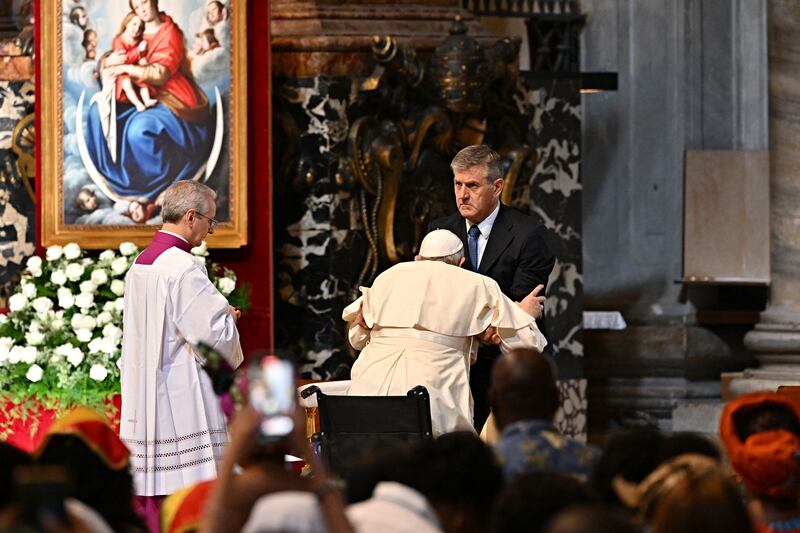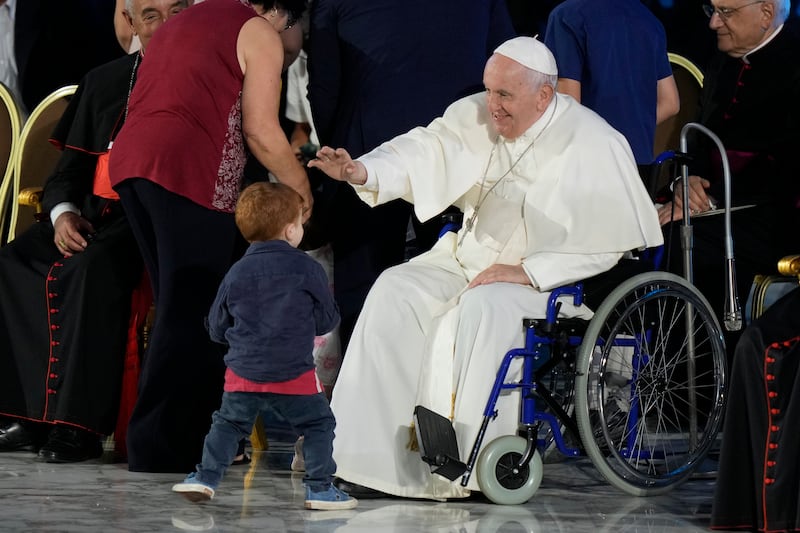When Pope Francis landed in Canada last week, he lumbered out of a car on the tarmac, hobbled with difficulty to an awaiting wheelchair and froze in place as cameras shot at close range the spectacle of an aide adjusting the pontiff’s foot rests.
On a makeshift stage outside an indigenous cemetery in Alberta, the world watched as he gathered his strength and grasped the arms of the aide, who lifted him out of his wheelchair.
In Lac Ste Anne, a remote lake renowned for its miraculous healing powers, hundreds of worshippers waiting for Francis in a shrine adorned with the crutches and canes of the cured, gasped in unison as the pope’s wheelchair hit a snag and he lurched dangerously forward.
A Vatican video feed quickly cut away. But seeing Francis in his increasing frailty and advancing old age was very much a point of his visit.
While the pontiff’s main mission in Canada was what he called a “pilgrimage of penance” to apologise to indigenous people for the horrific abuses they endured in church-run residential schools, it was also a pilgrimage of senescence in which the pontiff (85) used his own vulnerability to demand dignity for the aged in a world increasingly populated by them.
There needed to be built “a future in which the elderly are not cast aside because, from a ‘practical’ standpoint, they are no longer useful,” Francis said at a Mass at Commonwealth Stadium in Edmonton, Alberta, one of the few events in a papal travel schedule that was much lighter than usual. “A future that is not indifferent to the need of the aged to be cared for and listened to,” he added.
Francis, heavier, slowed by major intestinal surgery last year and suffering from torn knee ligaments and sciatica, is not the first pope to make the dignity of the aged a central concern of his later papacy.
The once vigorous John Paul II spent his last years folded over, ravaged by Parkinson’s. For some, his ailing magnified his spirituality and echoed the suffering of Christ on the cross.

For others, it was a disconcerting decline and raised questions about the governance of the Catholic Church. His successor, Pope Benedict XVI, cited his flagging energy as the reason for his resignation, a historic break with papal practice that has cast a shadow over Francis and his physical decline.
Resigning has “never entered my mind”, Francis said in a recent interview, before inserting his usual qualification, that his calculation could change if failing health made it impossible for him to run the church.
But if Benedict opted out, and severe disease left John Paul II with no choice but to put his ailing front and centre, Francis is purposefully, and incessantly, trying to reshape modern society to be more hospitable to the old.
Universal fragility
A top Vatican official, Archbishop Vincenzo Paglia, president of the Pontifical Academy for Life, said in a recent interview that he had persuaded Francis to articulate a new church teaching on ageing that was also “proposed not with words but with the body” because, he said, “the old can teach us that we all are, in reality, fragile”.
“Ageing is one of the great challenges of the 21st century,” added Paglia, who also presides over an Italian health ministry commission for the reform of the health and social care of older people in Italy, which has one of the oldest populations in the world.
A United Nations report has predicted that people aged 60 and over will exceed people under 15 by 2050.
Paglia said advancements in longevity science and medicine extended lifespans by decades and created “a new population of old people”. But that also created a contradiction, he added, because a society obsessed with living longer had not changed to accommodate those of advanced age, either economically, politically or even spiritually.
As pope, he appeared in a Netflix documentary on ageing, and he regularly denounces the way older people are treated like garbage in a “throwaway culture”
Starting even before he became pope aged 76, Francis has paid special attention to older people. In the book On Heaven and Earth, he said ignoring the health needs of older people constituted “covert euthanasia” and that the aged often “end up being stored away in a nursing home like an overcoat that is hung up in the closet during the summer”.
As pope, he appeared in a Netflix documentary on ageing, and he regularly denounces the way older people are treated like garbage in a “throwaway culture”.
In 2013, the year of his election, he used World Youth Day celebrations to honour older people. In a 2014 pre-Easter ritual meant to underline his service to humanity, he washed and kissed the feet of older and disabled people in wheelchairs. In 2021 he established an annual World Day for Grandparents and the Elderly to honour the “forgotten.”
That came during some of the worst days of the Covid pandemic and what Paglia said was a “massacre of the elderly” in Italian nursing homes that prompted his office to produce a “new paradigm” on caring for the old.
This year, Francis has sought to give shape to that thinking with a catechesis series, or religious instruction, on ageing.
Spread out over 15 speeches, with three more expected in August, according to the Vatican, he has called the booming population of the old a “veritable new people” in human history. “Never as many as now, never as much risk of being discarded,” he said.
He has promoted dialogue between the young and old, championing the benefit of hearing history directly from the people who lived it. He has also said that spending time with the old forces people to slow down, turn off their phones and follow a deeper clock.
“When you return home and there is a grandfather or grandmother who is perhaps no longer lucid or, I don’t know, has lost some of their ability to speak, and you stay with him or with her, you are ‘wasting time’, but this ‘waste of time’ strengthens the human family,” he has said.
Enriching the young
Exposure to decline and frailty, he noted, enriches the young. Reciprocally, he has said, “there is a gift in being elderly, understood as abandoning oneself to the care of others”.
Since his knee gave out, Francis has had to depend, at first seemingly reluctantly, on others to move around. And while his speeches draw heavily from the lessons of biblical figures, he has also peppered then with his own experiences: “You’re telling me; I have to go around in a wheelchair, eh?” he said in one speech. “But that’s how it is; that’s life.”

If Francis still sometimes uses a cane (“I think I can do it,” he said about walking around to greet journalists on the plane to Canada) he seems to have embraced the advantages of a wheelchair. After addressing a largely indigenous congregation at an Edmonton church, he took a veritable joyride among the cheering faithful outside, causing a chaotic scene as his aide even popped a wheelie to lower him over a curb.
Last week in Lac Ste Anne, his papal butler wheeled him to the lip of the lake, unlocked the pope’s foot rests so his feet could touch the sacred ground and stepped back as Francis prayed alone.
Rochelle Knibb (50), a Catholic from the Cree Nation, stood a few feet away with her mother, Margaret (74), who wore a bandage on her arm.
“In our culture, we put our elders first. The pope does that too,” Knibb said, adding that she saw the face of all the old in his.
“People are taking care of him, which is good,” she said. “That’s what I want for our elders as well.” — This article originally appeared in The New York Times










